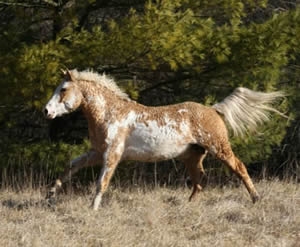History
There are multiple theories for how the American Curly developed. The Curly horse was first documented in Eureka, Nevada in the early 20th century by rancher John Damele and his sons. While Mustangs were a common sight, curly coated horses were unusual. Years later, the Dameles managed to catch one, broke it to ride and sold it, thus starting their relationship with the breed. In 1932, an unusually harsh winter hit the area, and come spring the only horses that could be found were the Curlies. This evidence of hardiness was noted by the Damele family, and they decided they should include more of these horses in their herd. After another harsh winter in 1951/52, the Dameles started to get serious about breeding these horses. They went out and found their foundation stallion, a two year old chestnut in one of the mustang herds. They called him Copper D. The Dameles didn't care much for keeping the breed 'pure', and wanting to improve their horses, added some other blood to their herd. Among the stallions introduced were a Morgan, Ruby Red King AMHR 26101 and an Arabian, Nevada Red AHR 18125. These two stallions created many offspring for the Dameles, and are in hundreds of Curly horses' pedigrees today.
The Bashkir Curly gets it name from the ancient Russian breed, the Bashkir, from which the modern Curly was believed to have descended. However, the American horses may have been incorrectly named. Research done by Shan Thomas for the CS Fund and resulting in the report, Myth and Mystery: The Curly Horse in America, indicates that the Russian breed most often found with the curly coat is the Lokai breed, found in the Taijikistan region.
Behavior
Their most cherished quality is their calmness and extremely gentle disposition. We do feel that this is one of their finest features. Many have been taken off the open range, even full grown animals, and in a day or two, they are gentler than horses that have been handled for years. Nothing seems to ruffle them. They do not tend to resort too flight when frightened, which has been claimed the horse's greatest means of survival. Curlies, with their naturally curious nature, prefer to face the unknown rather than run from it. If they feel something is a real danger to them, they prefer to kick rather than run. Although they will struggle frantically when first roped or haltered, they soon respond to kindness and affection because of their inherent gentle nature. They seem unable to cope with or tolerate abuse. They will tend to freeze in a tight spot so seldom get themselves hurt, even if caught in barbed wire. They will delight in human companionship and love to be talked to.
Function
Though eye catching and unusual in the show ring, Curlies have the movement, endurance, and heart to excel in competition. Curlies have been shown at upper levels of dressage and show jumping, and others have proved the reliable mount and patient teacher for the weekend competitor. Curlies are characteristically quiet, level headed horses that make excellent first horses for supervised beginner riders. Curlies have carried horse-allergic riders from beginner status through ever more advanced stages of equestrianism. They have also been used for combined driving, western riding, ranch horses, trail horses, and companions for other horses. Some Curlies have been crossbred to gaited horses. About 10% of the crossbreds will do one of the ambling gaits such as the running walk, fox trot or the stepping pace, which is also called the "Curly shuffle." Curlies are not used for racing or high trotting showing.
Health
No breed related genetic illnesses were found.
Curlies are claimed to be the only hypoallergenic horse breed; most people allergic to horses can handle Curly Horses without suffering any allergic reaction. Research indicates a protein is missing from the hair of Curlies which may be what causes allergic reactions to horses in allergy sufferers, but the study was never officially published. Members of the Curly community are working towards funding more research on the topic.






